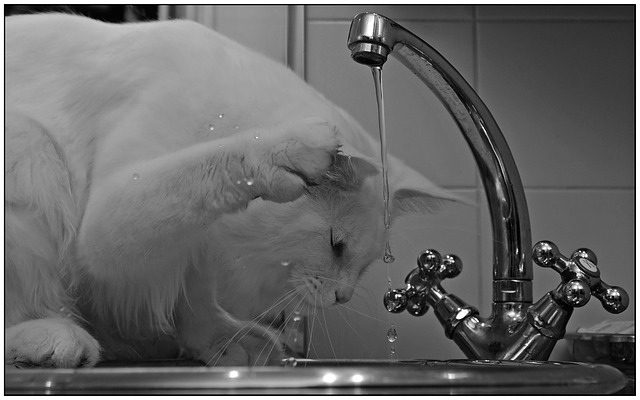Tap

|
| A typical mixer tap with separate hot- and cold-water controls. |
[edit] Introduction
A tap is a valve that is used to control the flow of liquid (or gas) exiting a supply source. It is an opening and closing device that allows the required amount ofl, for example water, to flow out of a supply system. In the USA, taps are called faucets.
Taps can be used to control various liquids and gases, such as water, oil and natural gas. Opening and closing is usually achieved by a rotation of a lever or handle, whether by numerous turns or by a quarter turn. In a laboratory setting, taps will usually be referred to as gas taps. Traditional domestic cookers also had gas taps.
NB Short Guide: Climate Change Adaptation for Traditional Buildings, published on 10 July 2017 by Historic Scotland, defines a faucet as: ‘The flange on a downpipe, allowing connection with the one above.’
[edit] Types of domestic water tap
Numerous types of water tap may be seen in homes:
- Rising spindle tap – this is the traditional design featuring a spindle and washer that can move up and down when the handle is turned. Bib taps are an example and are typically fixed to say, an external wall for watering purposes. They may also be the main stop-cock (tap) that regulates water flow into the dwelling.
- Non-rising head taps – feature a non-revolving spindle with a handle which traditionally has been made of clear plastic.
- Ceramic disc taps – have precision-ground, rotating ceramic discs in place of a washer.
- Pillar taps – in the kitchen or bathroom, the tap is mounted on the end of a stub post; there may be one for hot water and another for cold water.
- Mixer taps – seen in the kitchen and bathroom, these have become very popular in recent years. They can mix the water, i.e combine the hot and cold water flows out through a common spout to provide water at the required temperature. Mixer taps can be operated by a single lever which regulates both the flow and the temperature, according to the position it is set to. Or they can have two separate hot and cold taps that convey the water through a common spout.
Most domestic taps are available in a variety of finishes, including satin chrome-plated, stainless steel or enamelled brass.
[edit] Related articles on Designing Buildings
- Approved document G.
- Boiler.
- Dishwasher.
- Hot water.
- Hot water safety.
- Natural gas.
- Passive water efficiency measures.
- Pipework.
- Plumbing drawing.
- Plumbing.
- Radiator.
- Sanitary appliances.
- Sanitary pipework.
- Sentinel taps.
- Types of domestic boiler.
- Types of washer.
- Types of water.
- Valves.
- Vertical riser.
- Water.
Featured articles and news
RTPI leader to become new CIOB Chief Executive Officer
Dr Victoria Hills MRTPI, FICE to take over after Caroline Gumble’s departure.
Social and affordable housing, a long term plan for delivery
The “Delivering a Decade of Renewal for Social and Affordable Housing” strategy sets out future path.
A change to adoptive architecture
Effects of global weather warming on architectural detailing, material choice and human interaction.
The proposed publicly owned and backed subsidiary of Homes England, to facilitate new homes.
How big is the problem and what can we do to mitigate the effects?
Overheating guidance and tools for building designers
A number of cool guides to help with the heat.
The UK's Modern Industrial Strategy: A 10 year plan
Previous consultation criticism, current key elements and general support with some persisting reservations.
Building Safety Regulator reforms
New roles, new staff and a new fast track service pave the way for a single construction regulator.
Architectural Technologist CPDs and Communications
CIAT CPD… and how you can do it!
Cooling centres and cool spaces
Managing extreme heat in cities by directing the public to places for heat stress relief and water sources.
Winter gardens: A brief history and warm variations
Extending the season with glass in different forms and terms.
Restoring Great Yarmouth's Winter Gardens
Transforming one of the least sustainable constructions imaginable.
Construction Skills Mission Board launch sector drive
Newly formed government and industry collaboration set strategy for recruiting an additional 100,000 construction workers a year.
New Architects Code comes into effect in September 2025
ARB Architects Code of Conduct and Practice available with ongoing consultation regarding guidance.
Welsh Skills Body (Medr) launches ambitious plan
The new skills body brings together funding and regulation of tertiary education and research for the devolved nation.
Paul Gandy FCIOB announced as next CIOB President
Former Tilbury Douglas CEO takes helm.
UK Infrastructure: A 10 Year Strategy. In brief with reactions
With the National Infrastructure and Service Transformation Authority (NISTA).






















